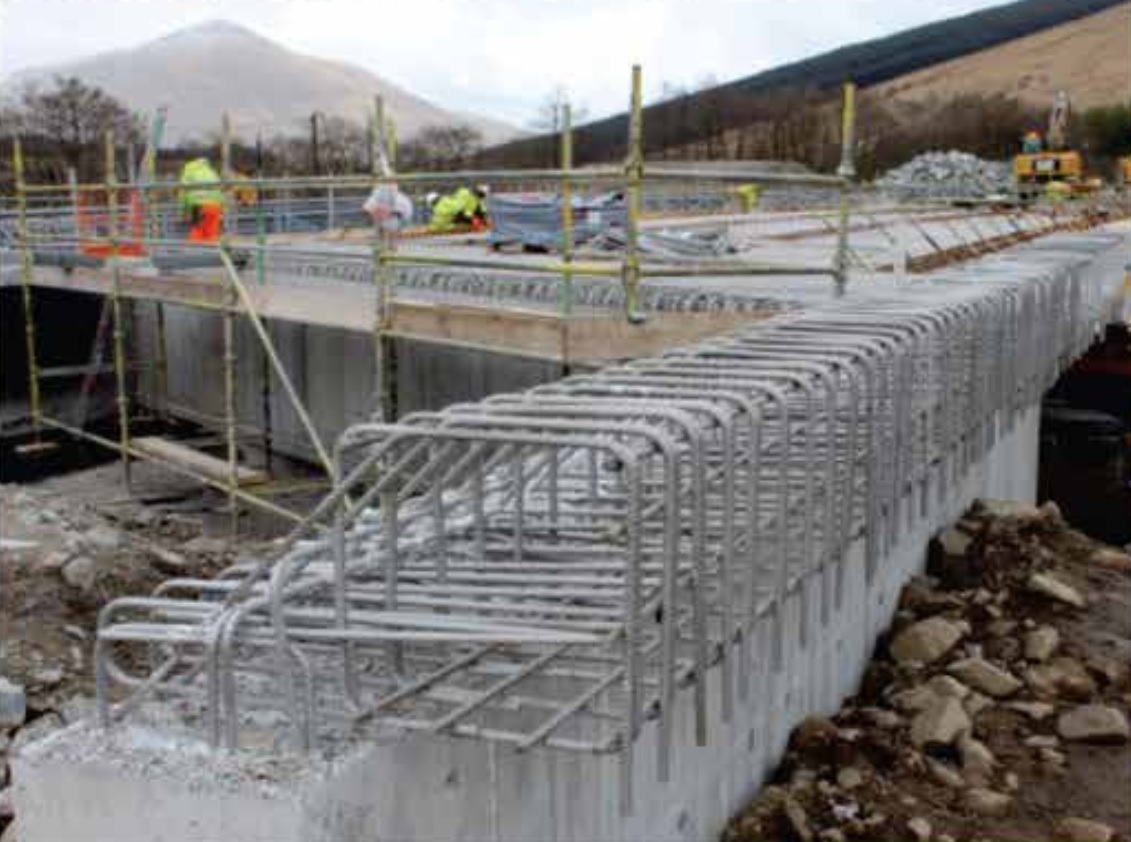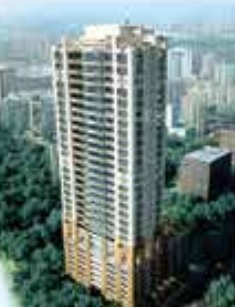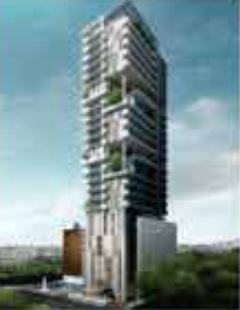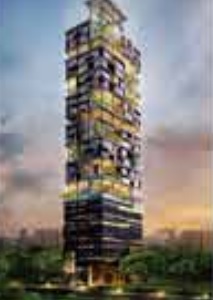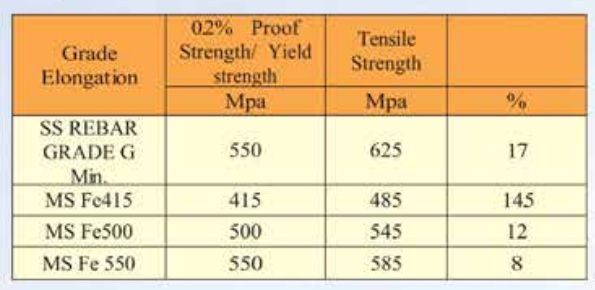About Us
Sunflag Iron & Steel Co. Ltd.. lNDIA is a part of the renowned Sunflag Group. The sunflag Group was founded in Kenya in 1937. It has a diversified range of‘activities in Kenya,Tanzania Nigeria, Comeroon,The United Kingdom & India employing over 10,000 people.
In India Sunflag Iron & Steel Co. Ltd. (SlSCO) activity is divided into two business segment : Steel and Stainless Steel products and power sector. SISCO has set—up an integrated steel plant with technical know-how and major equipments from MANNESMANN DEMAG and KRUPP of Germany. It is most modern plant, the first integrated steel plant of its kind in India with a capacity of 0.5 million tonnes per annum of rolled products, which are comparable to the best in the world. This plant produces alloy steels, special steels and stainless steels, which are also supplied to major automobile manufacturers in India and a large part of our production is exported. SISCO has its own captive thermal power plant to meet the requirement of steel plant.
With ISO 9001/ IATF16949 organisation we provide best quality of steel to our customers.







Previous
Next
Reinforcement Stainless Steel Rebars (Ferritic)
Grade G of IS 16651:2017
What is SS Rebar Grade G?
It is a new kind of stainless steel rebar first introduced in India by Sunflag Steel. SS Rebar Grade G is a low cost stainless containing 11-13.5% Chromium rebar that has a good corrosion resistance. SS REBAR GRADE G is a new age building material which increase the life of the building because of its better corrosion resistance properties compared to TMT, Epoxy coated or Zinc coated rebars.
Why SS Rebar Grade G?
Like any other rebar SS REBAR GRADE G does the job of reinforcement. The concrete inner structure of any building is made of steel . Due to formation of chromium oxide layer on the surface when exposed to atmosphere the SS REBAR GRADE G rebar does not get corroded. This protective oxide layer improves the life of rebar in concrete. In twenty first century SS REBAR GRADE G is a gift to builder, architect and consumer for corrosion free structure.
Corrosion in Concrete Structure
The corrosion of reinforcing bar can result in cost maintenance and repair of concrete structures. Corrosion may occur as a result of carbonation of the concrete, which destroys the protective passive layer surrounding the reinforcing bar. In marine environments, chemical and mineral processing plants etc., corrosion is usually caused by the ingress of highly corrosive chloride ions through the concrete to the reinforcing bar. The products of Corrosion (Iron salts and oxides) of the reinforcing bar occupy a considerably greater volume than the original steel resulting in the cracking and subsequent spalling of the concrete. The corrosive attack on the reinforcement then becomes very rapid as the steel is no longer protected by the concrete cover.
The structure will soon weaken to the point where it will become unserviceable or dangerous.
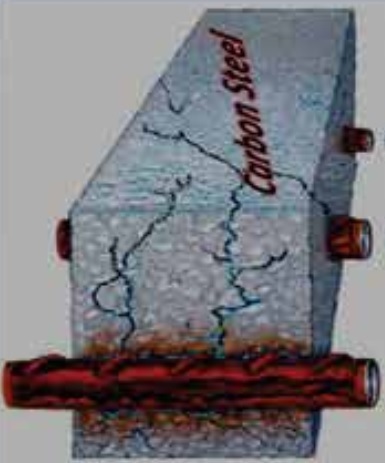
Carbon Steel
Iron expansion inside due to increase in volume of rusting product from reinforced bar and thus the cracking and spalling.

RSST (F) G IS 16651:2017
Passive layer of chromium oxide prevents rusting.
To protect the concrete structure from corrosion few techniques have been adopted without much success.
- Coatings on the steel bars.
- Using Alloy Steel in the place of Carbon Steel.
- Cathodic Protection
- Addition of lnhibitors in the concrete.
- Increase concrete cover thickness.
- Reduced water /cement ratios
Though application of coatings to rebar is an easy route, damage of coatings during handling is the main limitation. Effect of inhibitors is temporary and short-lived. Cathodic protection is perhaps the perfect method but is difficult to implement and requires post maintenance and monitoring (Stainless steel is therefore the only solution for enhancing corrosion protection of concrete).
Low alloy steel with alloy concentration – 1% or so are also not the answer, where the concrete is exposed to both high levels of urban pollution and aggressive marine environment.
What Type of Stainless Steel Can be Used In the
Reinforcement of Concrete?
A wide range of stainless steel alloy types is available for rebar selection, to meet the mechanical design aspects and the expected corrosivity of the environment. Stainless Steels are available mainly in five main groups. Austenitic, Ferritic, Duplex, Martensite and Precipitation hardened steels. Depending upon several factors such as relative corrsion, longevity, life cycle cost the SS REBAR GRADE G Stainless Steel is a desirable material. SS REBAR GRADE G is currently used by Orbit Buildcon & Reality [P] Ltd. in Mumbai for their premium housing projects. Orbit Buildcon is a famous construction company located in Mumbai.
Stainless Steel Rebar SSR 550
Intrinsic Properties of SS Rebar Grade G
Carbon and Nitrogen control the mechanical properties of StainlessSteel. Higher Carbon and Nitrogen contents are harmful for reinforcement purposes,since these result in a steel with low weldability and low toughness (Control of Carbon content to 300 ppm max and Nitrogen content to 300 ppm max). resuIts in the formation of a fine equiaxed ferritic steel with good toughness and adequate mechanical properties .That makes SSR 550, Grade G of is 16651:2017 the best stainless steel for reinforcement of concrete.
Chemical composition of SS Rebar Grade G
| Chemical | C | Ni | Mn | Si | P | S | Cr | N |
| Min% | 0.0 | – | – | – | – | 11 | – | |
| Max% | 0.03 | 0.60 | 1.0 | 1.0 | 0.04 | 0.030 | 13.50 | – |
Properties of SS Rebar Grade G
Equivalent Standards
SS REBAR GRADE G falls in IS I6551:2017 and also A;LSzO Conforms to all requirements of equivalent grade in JIS G 4322: 2008
Physical Properties
Size & Mass
| Nominal Diameter (mm) | Nominal Mass/M (kg/m) | Nominal Sectional Area (mm2) | Cirumference(mm) |
| 8 | 0.395 | 50.27 | 25.13 |
| 10 | 0.167 | 78.54 | 31.42 |
| 12 | 0.888 | 113.10 | 37.70 |
| 16 | 1.578 | 201.10 | 50.27 |
| 25 | 2.466 | 490.90 | 78.53 |
| 32 | 6.313 | 804.20 | 100.50 |
Cutting
SS REBAR GRADE G has good cutting property and can be easily cut by a mechanical shear or abrasive disc with less tool/disc wear but it is advised not to cut by an oxy-acetylene flame.
Welding
SS REBAR GRADE G has good weldability because of its fine grained structure. Filler material such as AFRIX RSSR (F) G IS 16651:2017, or austenitic stainless steel filler materials such as R309L or 316L are preferred.
in marine environments, chemical and mineral processing plants etc., corrosion is usually caused by the ingress of highly corrosive chloride ions through the concrete to the reinforcing bar. The products of corrosion (lron salts and oxides) of the reinforcing bar occupy a considerably greater volume than the original steel resulting in the cracking and subsequent spelling of the concrete.
Immersion tests in various solutions show eligible corrosion rate (Table 1) of SS Rebar Grade G.
Table 1
Stainless Steel Rebar SSR 550 (G)
Advantages of SS Rebar Grade G
-
- SS REBAR GRADE G has inherently good corrosion
resistance like any other stainless steel due to chromium oxide layer on the surface.
- SS REBAR GRADE G has inherently good corrosion
-
- It has good high and low temperature tensile as well as yield strength to match or exceed carbon steel.
-
- In RSSR (F) G IS 16651:2017, no cathodic protection is
required.
- In RSSR (F) G IS 16651:2017, no cathodic protection is
-
- It has got good weldability due to very low percentage of carbon content {i.e.,0.03% max.)
-
- It has very good ductility.
-
- No coating is required here to have adequate corrosion resistance.
-
- It can be shipped, handled and bent without any problem.
-
- SS Rebar GRADE G excellent earthquake resistance
due in high percentage of elongation and ductility.
- SS Rebar GRADE G excellent earthquake resistance
- Establish Examples of use of similar Stainless Steel Rebars
In South Africa
A Similar Product 3CR12 has been used extensively for many projects in bridges, building……
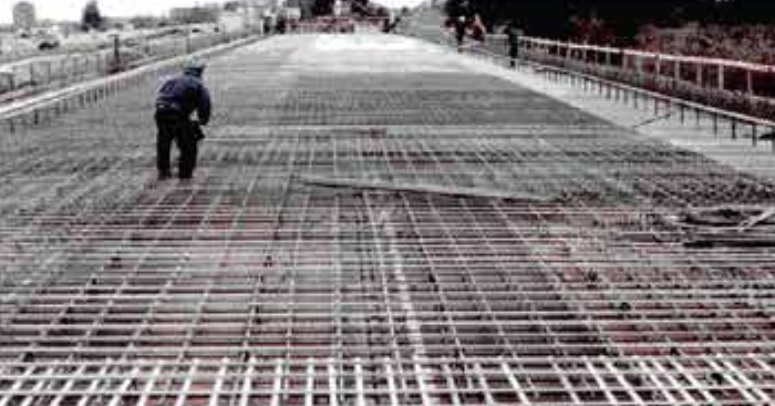
Switzerland & Part of Europe
In the region it is produced and promoted by SWISS steel under the brand name of TOP 12.
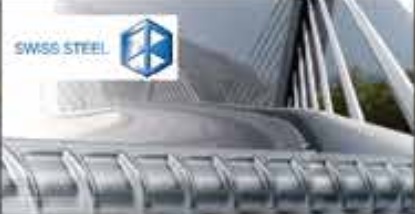
Japan
In Japan ferritic stainless steel rebar is being produced by Nippon Steel & Sumikin Stainles Steel Corporation under the brand name of NSSD410—295 External Wall of Nippon Keidanren Building of NSSD 410-295
Stainless Rebar
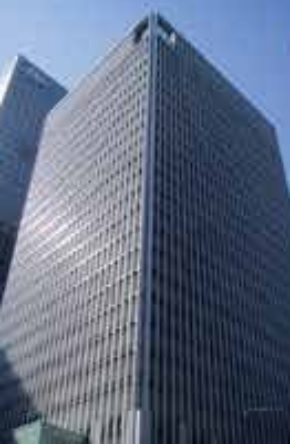
Life Cycle Cost
Life cycle costing estimates the total cost of product from initial outlay , through all related future cots may be incurred as Consequence of initial investment decisions. While making any building or RCC structure the inital investment is going to be higher as there is price gap between Carbon Steel Rebar and SS Rebar Grade G . But in the long run there will be a major savings as building made by SS REBAR GRADE G does not need any maintenance/replacement. Hence, higher investment cost gets offset due to low maintenance.
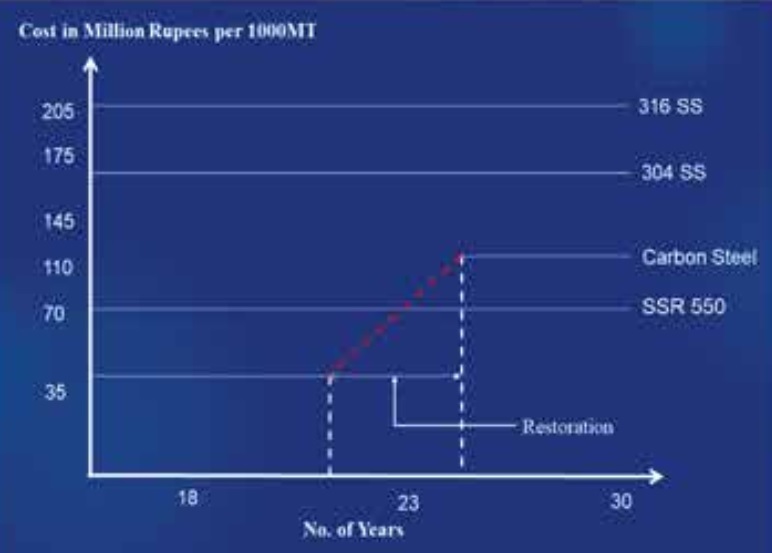

The cost of adequate prevention carried out during the stages of design and execution are minimal
compared to the savings they make possible during the service life
SS Rebar Grade G Rebars are Characterized by Superior Mechanical Properties, Ductility & Enhanced Life. It’s Built to Last Longer
Certificates
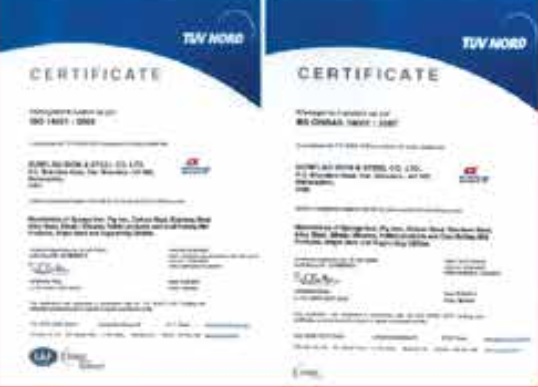
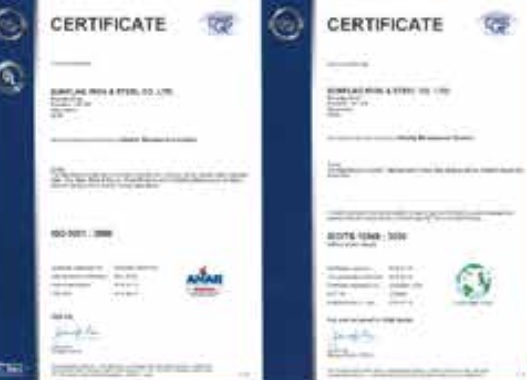
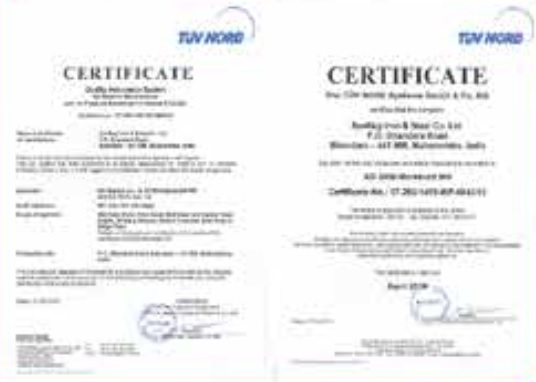
It is a new kind of stainless steel rebar first introduced in India by Sunflag Steel. SS Rebar Grade G is a low cost stainless containing 11-13.5 % Chromium rebar.

